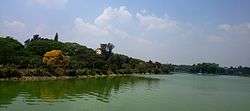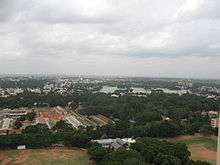Ulsoor Lake
| Halasuru Lake | |
|---|---|
 Halasuru Lake | |
| Location | Bangalore, Karnataka |
| Coordinates | 12°58′53.3″N 77°37′9.17″E / 12.981472°N 77.6192139°E |
| Type | Stalewater |
| Primary inflows | Rainfall and city drainage |
| Primary outflows | Nala |
| Catchment area | 1.5 km2 (0.6 sq mi) |
| Basin countries | India |
| Surface area | 50 ha (123.6 acres) |
| Average depth | 19 ft (5.8 m) |
| Max. depth | 58 ft (18 m) |
| Shore length1 | 3 km (1.9 mi) |
| Surface elevation | 931 m (3,054.5 ft) |
| Islands | several islands |
| Settlements | Bangalore |
| 1 Shore length is not a well-defined measure. | |

Ulsoor Lake' or Halasuru Lake, one of the biggest lakes in Bangalore, is located on the eastern side of the city. It derives its name from the name of the locality it is situated, namely, Halasuru , close to M G Road. It is spread over 50 ha (123.6 acres)) and has several islands. Even though the lake is dated to Kempegowdas' time, the present lake was created by Sir Lewin Bentham Bowring, the then Commissioner of Bangalore.[1][2]
The lake was subject to several types of pollution threats.[3][4][2]
Water quality
.jpg)
The health of the lake eco-system was, therefore, monitored at six monitoring points on the lake for light, temperature, oxygen, nutrients and the type of aquatic plants that grow in the lake. During the study, it was noted that the lake which has catchment area of 1.5 km2 (0.6 sq mi) is fed by three drains at different locations; the first drain is from the Madras Engineering Group (MEG) Centre (of the Army), the second drain is from Jeevanahalli and the third drain is from Doddigunta and traverses through Kattariyamma garden, Godhandappa garden, Munivenkattappa garden, Muthamma garden, Muniamma garden, Kempurayana Garden and New Corporation colony and all these areas are within 1 km (0.6 mi) from the lake and inhabited by slums dwellers.[5] The study showed that the daytime DO was very high; varying between 0.2 and 4.5 mg/L. The saprobic nature of the lake water was confirmed by the P/R ratio which was less than one. Eutrophication of the lake was confirmed by further studies which indicated phosphate, nitrogen and chlorophyll levels to be high; with Blue green algae (which is toxic and utilises DO in the night) called the microcystis was noted from surface to bottom of the lake. This affected the aquatic plants and fish (only a few fish species remained). Further studies established the presence of high concentrations of zinc and the metal content in water samples, concentration of Zn, Cd, Cr, Pb and Cu content was found to be very high in sludge samples with depth sludge recorded as about 1.55 m (5.1 ft).[5]
These studies confirmed the need for urgent restoration and remedial actions in the form of:[5]
- Desilting of the lake is to eliminate contaminants
- Stop all encroachments of the lake with suitable fencing
- Only storm water should be allowed into the lake
- Army units should discontinue effluents from cattle house wash, cowdung wash and army mess wash and consider installation of a biogas plant.
- Plastic bags to be prevented from draining into the lake
- Sewage/manholes at identified locations to be closed.
- Drain water from slum around the lake to be treated before draining into the lake. Preferably, connect the slum storm water and wastewater drain to the nearby Cox Town sewage drain as it is close to the slums
- Prohibit submergence of idols during the festival season
- Remove all slum dwellers from region
- Cultivate and harvest fishes and aquatic plants to deplete the nitrogen and phosphate content
Restoration works
Restoration works, listed below, have resulted in improvements in the lake environment.[3][4][2]
- Aeration of wastewater that is led into the lake
- Park and swimming pool improved
- Desilting of the lake bed and thus increasing depth and the capacity of the lake
- Installation of silt traps at the mouth of the storm water inlets
- Diversion of underground sewages lines from the eastern part of the City through 900 mm pipes bypassing the lake
- Restoration of Aquatic life by introduction of fish species natural to the lake and induction of suitable water plants
- Chain–link fencing to prevent people dumping garbage into the lake
- Boat training facility of Madras Engineering Group (MEG) improved
- Access to public from 9 am to 6 pm with holiday on Wednesday
It is reported that cleanliness drive has breathed new life to the lake.[2]
References
- ↑ B. L. Rice. Gazetteer of Mysore. p. 71. Retrieved 2017-02-23.
- 1 2 3 4 "Halasuru Lake: Clogged lung space". Web.archive.org. 2009-02-02. Archived from the original on 2009-02-02. Retrieved 2017-02-23.
- 1 2 "The Hindu : Ulsoor Lake restoration on schedule". The Hindu. April 17, 2003.
- 1 2 "3. Study Area". Wgbis.ces.iisc.ernet.in. Retrieved 2017-02-23.
- 1 2 3 "STATUS OF ULSOOR LAKE WATER QUALITY BETWEEN 1996-97". Ces.iisc.ernet.in. Retrieved 2017-02-23.
| Wikimedia Commons has media related to Ulsoor Lake. |